 W
WAsherman's syndrome (AS), is an acquired uterine condition that occurs when scar tissue (adhesions) form inside the uterus and/or the cervix. It is characterized by variable scarring inside the uterine cavity, where in many cases the front and back walls of the uterus stick to one another. AS can be the cause of menstrual disturbances, infertility, and placental abnormalities. Although the first case of intrauterine adhesion was published in 1894 by Heinrich Fritsch, it was only after 54 years that a full description of Asherman syndrome was carried out by Joseph Asherman. A number of other terms have been used to describe the condition and related conditions including: uterine/cervical atresia, traumatic uterine atrophy, sclerotic endometrium, and endometrial sclerosis.
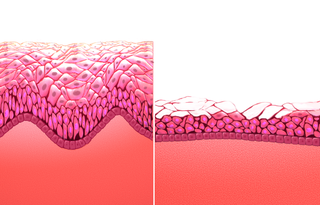 W
WAtrophic vaginitis is inflammation of the vagina as a result of tissue thinning due to not enough estrogen. Symptoms may include pain with sex, vaginal itchiness or dryness, and an urge to urinate or burning with urination. It generally does not resolve without ongoing treatment. Complications may include urinary tract infections.
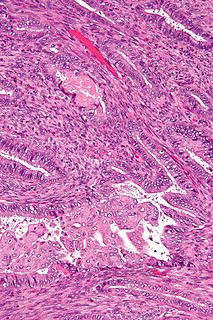 W
WAtypical polypoid adenomyoma (APA) is a rare uncommon benign tumour of the uterus.
 W
WCervical intraepithelial neoplasia (CIN), also known as cervical dysplasia, is the abnormal growth of cells on the surface of the cervix that could potentially lead to cervical cancer. More specifically, CIN refers to the potentially precancerous transformation of cells of the cervix.
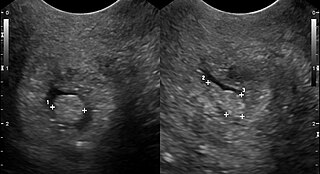 W
WA cervical polyp is a common benign polyp or tumour on the surface of the cervical canal. They can cause irregular menstrual bleeding but often show no symptoms. Treatment consists of simple removal of the polyp and prognosis is generally good. About 1% of cervical polyps will show neoplastic change which may lead to cancer. They are most common in post-menarche, pre-menopausal women who have been pregnant.
 W
WA corpus luteum cyst is a type of ovarian cyst which may rupture about the time of menstruation, and take up to three months to disappear entirely. A corpus luteum cyst rarely occurs in women over the age of 50, because eggs are no longer being released after menopause. Corpus luteum cysts may contain blood and other fluids. The physical shape of a corpus luteum cyst may appear as an enlargement of the ovary itself, rather than a distinct mass -like growth on the surface of the ovary.
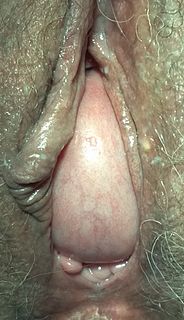 W
WA cystocele, also known as a prolapsed bladder, is a medical condition in which a woman's bladder bulges into her vagina. Some may have no symptoms. Other may have trouble starting urination, urinary incontinence, or frequent urination. Complications may include recurrent urinary tract infections and urinary retention. Cystocele and a prolapsed urethra often occur together and is called a cystourethrocele. Cystocele can negatively affect quality of life.
 W
WDysplasia is any of various types of abnormal growth or development of cells and/or organs, and/or the abnormal histology or anatomical structure presumably resulting from such growth. Dysplasias on a mainly microscopic scale include epithelial dysplasia and fibrous dysplasia of bone. Dysplasias on a mainly macroscopic scale include hip dysplasia, myelodysplastic syndrome, and multicystic dysplastic kidney. In one of the modern histopathologic senses of the term, dysplasia is sometimes differentiated from other categories of tissue change including hyperplasia, metaplasia, and neoplasia, and dysplasias are thus generally not neoplastic. An exception is that the myelodysplasias include a range of benign, precancerous, and cancerous forms. Various other dysplasias tend to be precancerous. The word's meanings thus span across a spectrum of histopathologic variations.
 W
WEndometrial hyperplasia is a condition of excessive proliferation of the cells of the endometrium, or inner lining of the uterus.
 W
WAn endometrial polyp or uterine polyp is a mass in the inner lining of the uterus. They may have a large flat base (sessile) or be attached to the uterus by an elongated pedicle (pedunculated). Pedunculated polyps are more common than sessile ones. They range in size from a few millimeters to several centimeters. If pedunculated, they can protrude through the cervix into the vagina. Small blood vessels may be present, particularly in large polyps.
 W
WEndometrioma is the presence of endometrial tissue in and sometimes on the ovary. It is the most common form of endometriosis. Endometrioma is found in 17–44% patients with endometriosis. Endometriomas are typically an advanced form of endometriosis, around stage three or four. More broadly, endometriosis is the presence of endometrial tissue located outside the uterus. The presence of endometriosis can result in the formation of scar tissue, adhesions and an inflammatory reaction. It usually is a benign growth. An endometrioma is most often found in the ovary. This ovarian endometriosis forms dark, fluid-filled cysts. These fluid-filled sacs can vary greatly in size and are known as endometriomas, also called "chocolate cysts". The fluid inside the cysts is thick, dark, old blood, giving it a chocolate-like appearance. It can also develop in the cul-de-sac, the surface of the uterus, and between the vagina and rectum.
 W
WEndometriosis is a condition in which cells similar to those in the endometrium, the layer of tissue that normally covers the inside of the uterus, grow outside the uterus. Most often this is on the ovaries, fallopian tubes, and tissue around the uterus and ovaries; however, in rare cases it may also occur in other parts of the body. The main symptoms are pelvic pain and infertility. Nearly half of those affected have chronic pelvic pain, while in 70% pain occurs during menstruation. Pain during sexual intercourse is also common. Infertility occurs in up to half of affected individuals. Less common symptoms include urinary or bowel symptoms. About 25% of individuals have no symptoms and 85% of those seen with infertility in a tertiary center have no pain. Endometriosis can have both social and psychological effects.
 W
WFallopian tube obstruction is a major cause of female infertility. Blocked fallopian tubes are unable to let the ovum and the sperm converge, thus making fertilization impossible. Fallopian tubes are also known as oviducts, uterine tubes, and salpinges.
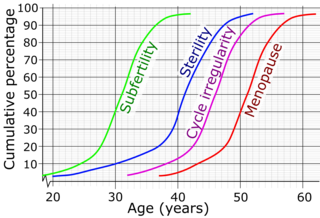 W
WFemale infertility refers to infertility in women. It affects an estimated 48 million women, with the highest prevalence of infertility affecting people in South Asia, Sub-Saharan Africa, North Africa/Middle East, and Central/Eastern Europe and Central Asia. Infertility is caused by many sources, including nutrition, diseases, and other malformations of the uterus. Infertility affects women from around the world, and the cultural and social stigma surrounding it varies.
 W
WFertility testing is the process by which fertility is assessed, both generally and also to find the fertile window. General health affects fertility, and STI testing is an important related field.
 W
WThe International Federation of Gynecology and Obstetrics is an international organization that links about 125 international professional societies of Obstetricians and Gynecologists. In 2011 FIGO recognized two systems designed to aid research, education, and clinical care of women with abnormal uterine bleeding (AUB) in the reproductive years. This page is a summary of the systems and their use in contemporary gynecology.
 W
WThe follicular cyst of the ovary is a type of functional simple cyst, and is the most common type of ovarian cyst.
 W
WHematometra is a medical condition involving collection or retention of blood in the uterus. It is most commonly caused by an imperforate hymen or a transverse vaginal septum.
 W
WHematosalpinx is a medical condition involving bleeding into the fallopian tubes.
 W
WKraurosis vulvae is a cutaneous condition characterized by atrophy and shrinkage of the skin of the vagina and vulva often accompanied by a chronic inflammatory reaction in the deeper tissues.
 W
WLeukorrhea or is a thick, whitish, yellowish or greenish vaginal discharge. There are many causes of leukorrhea, the usual one being estrogen imbalance. The amount of discharge may increase due to vaginal infection, and it may disappear and reappear from time to time. This discharge can keep occurring for years, in which case it becomes more yellow and foul-smelling. It is usually a non-pathological symptom secondary to inflammatory conditions of the vagina or cervix.
 W
WObstetric fistula is a medical condition in which a hole develops in the birth canal as a result of childbirth. This can be between the vagina and rectum, ureter, or bladder. It can result in incontinence of urine or feces. Complications may include depression, infertility, and social isolation.
 W
WAn ovarian cyst is a fluid-filled sac within the ovary. Often they cause no symptoms. Occasionally they may produce bloating, lower abdominal pain, or lower back pain. The majority of cysts are harmless. If the cyst either breaks open or causes twisting of the ovary, it may cause severe pain. This may result in vomiting or feeling faint.
 W
WOvarian torsion (OT) is when an ovary twists on its attachment to other structures, such that blood flow is decreased. Symptoms typically include pelvic pain on one side. While classically the pain is sudden in onset, this is not always the case. Other symptoms may include nausea. Complications may include infection, bleeding, or infertility.
 W
WPelvic congestion syndrome, also known as pelvic vein incompetence, is a long term condition in women believed to be due to enlarged veins in the lower abdomen. The condition may cause chronic pain, such as a constant dull ache, which can be worsened by standing or sex. Pain in the legs or lower back may also occur.
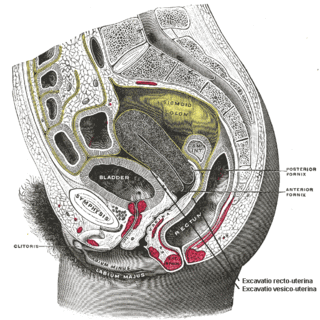 W
WA rectocele or posterior vaginal wall prolapse results when the rectum herniates into or forms a bulge in the vagina. Two common causes of this defect are: childbirth, and hysterectomy. Rectocele also tends to occur with other forms of pelvic organ prolapse such as enterocele, sigmoidocele and cystocele.
 W
WA rectovaginal fistula is a medical condition where there is a fistula or abnormal connection between the rectum and the vagina.
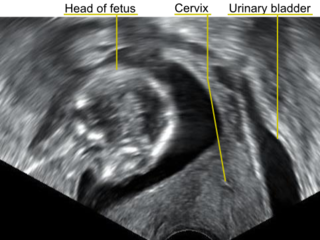 W
WA retroverted uterus is a uterus that is oriented posteriorly, towards the back of the body. This is in contrast to the slightly "anteverted" uterus that most women have, which is oriented forward toward the bladder, with the anterior part slightly concave.
 W
WSalpingitis isthmica nodosa (SIN), also known as diverticulosis of the Fallopian tube, is nodular thickening of the narrow part of the uterine tube, due to inflammation.
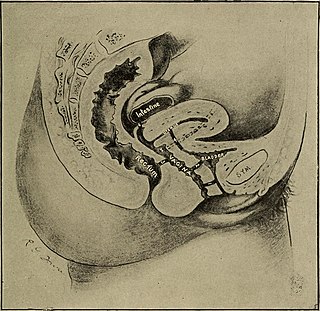 W
WA ureterovaginal fistula is an abnormal passageway existing between the ureter and the vagina. It presents as urinary incontinence. Its impact on women is to reduce the "quality of life dramatically."
 W
WUterine prolapse is when the uterus descends towards or through the opening of the vagina. Symptoms may include vaginal fullness, pain with sex, trouble urinating, urinary incontinence, and constipation. Often it gets worse over time. Low back pain and vaginal bleeding may also occur.
 W
WVaginismus is a condition in which involuntary muscle spasm interferes with vaginal intercourse or other penetration of the vagina. This often results in pain with attempts at sex. Often, it begins when vaginal intercourse is first attempted.
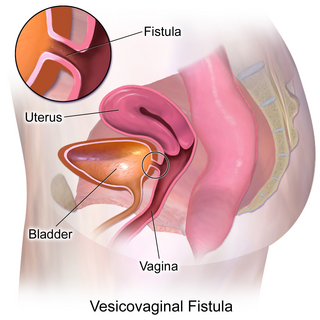 W
WVesicovaginal fistula (VVF) is a subtype of female urogenital fistula (UGF).